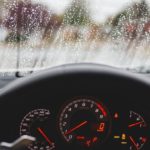Quick Navigation

Do you hear water sloshing around inside the car when you drive after the rains? It may be the rainwater trapped inside your car door. Even thinking about it is enough to make you feel worried.
Every time you drive when it rains or pass through a waterlogged area, water enters the car’s body. The same takes place when you wash the car too. Usually, car doors have a small hole as a drainage system to let out the trapped water.
If you check the bottom of the car door, you can see the drainage hole. It is sometimes covered with a decal.
However, they get blocked by dirt and debris over time. In such a case, the debris and sludge formation in the drainage hole passage does not let the water flow out. The water drainage may happen slower than the water fills up.
1. Inspect The Drainage Holes
The first thing you should do whenever there is a sloshing sound in the car is to check the drainage holes. When you wash the car or when it rains, the water enters through even the smallest openings in the windows and doors. You may hear that sloshing sound when you drive the car.
Also, check if you hear a strange squeaking and splashing sound when you open and close the door.
Go down and check if the holes at the bottom of the door are clogged by sludge. Too much water accumulation inside the car can cause rust formation. If you see signs of rust at the bottom of the doors or the car’s body just below the door, it has occurred due to excessive water inside the car for a long time.
Checking these drainage holes is not included in a professional car wash package. But you can always have a check yourself to be sure, and it isn’t really a difficult task.
2. Clean The Blocked Drainage Holes
Get down on your knees and inspect the drainage holes at the bottom of the car’s door. If you find that the holes have a tiny opening or are too few, you have to clean them quite frequently. Also, if you see them covered with dirt and sludge, it’s time to clean them.
The first method to clean them would be to poke the holes to clear the passage’s debris manually. You can use a pin, a screwdriver, or a similar sharp object that enters the hole and removes the debris. Poke the holes carefully, taking care not to damage the paint.
3. Use Water Jet Spray
Another way to clear the dirt, sludge, and debris blocking the holes is to blast them using a water spray. A high-pressure car wash can spray out the trapped debris in the holes and open them up. You can even use a garden hose pipe as a temporary measure to blast out the debris.
If you opt for professional car washing and cleaning services, you can specifically request them to spray water at high speed near the holes to clean the debris blocking it.
4. Test The Blockage
You can test whether you have solved the problem by waiting for the next rain. If the water traps inside again and sloshes around, the holes are still unclean. You need to clean them properly again. If it doesn’t, then your problem is solved till the holes get clogged with grime also.
Another method to test if you have solved the blockage problem is to wash your car. Use a water hose and run it over your vehicle, especially near the doors and windshield.

If you see the water draining through the holes, the blockage is cleared. If it is draining very slowly or not draining at all, you still have a blockage.
5. Remove The Rubber Covering
In some cars, the holes may be covered with a black rubber tube at the car’s door base. Some vehicles may have a small plug covering the holes, which pops open when you pull them out. In that case, you won’t be able to spot the holes without removing that black rubber covering.
Gently pull the rubber covering at the points it is fixed into the car’s door. You need to fix them again, and therefore, you must be careful not to break or damage the covering. As soon as you open the cover, you can spot the water gushing out of the hole.
Watch the places where the rubber covering is fixed and pull them out to uncover the holes and let the water out. This may take some time, depending on how much water is trapped inside the car.
Wait till all the water has drained and the sloshing sound has stopped before fixing the rubber covering again.
If you see rust formation near the holes after uncovering them, it may be due to water being trapped inside for too long. Covered drainage holes are better in one way. They are less prone to being blocked by dirt and debris.
You can uncover them to let the water out as per need and cover them again to protect them.
What Is The Best Method?
The best way to naturally allow the trapped water to exit from the car’s body is to keep the drainage holes clear. Check the drain holes in the bottom of the car, the rocker panels, or wherever they are located. Frequently inspect if they are clogged with dirt and debris.
Rustproofing treatment can also clog the drainage holes at times on the wrong treatment.
It’s best to clean your car at regular intervals using high-pressure wash at the holes to clear out any trapped debris or sludge. Please do not keep the car in dirty environments or leave it unclean for a long time to avoid dirt accumulation.
In case your car has too small drainage holes, make sure you clean them more frequently with a water jet or other cleaners.

With comprehensive experience in writing exceptional quality articles and blogs about cars and related stuff, Daniel is one of the finest bloggers and a hardcore car lover we have. He is an ASE certified technician with an across-the-board experience of 10 years in the industry. He could not help tinkering with anything he got his hands on from a young age, which led to his remarkable career in the automotive repair industry.
When he is not under any hood, you can find him on the water or in the woods to pursue his passion for hunting and fishing. He has been writing for multiple sectors and is a regular contributor to several publications.
He currently owns a Nissan 300ZX TT and a Pearl Yellow but plans to upgrade it to 550 HP. His favorites include the Koenigsegg CCX and Lamborghini Diablo 6.0 VT, but for him, the Ferrari 360 Spider is one of the sexiest cars that exists to date.
Being an avid world traveler, he has spent most of his time analyzing the automotive markets, latest technology, and local favorites to enhance his knowledge base. He is currently living in North Caroline, where it’s all about food and coffee and, of course, cars.






